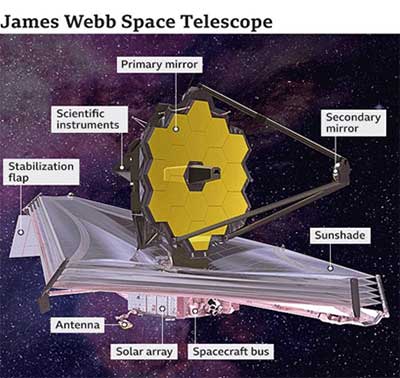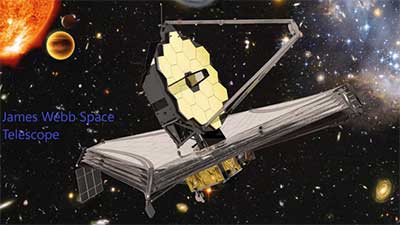Relevance: GS-3: Science and Technology- developments and their applications and effects in everyday life.
Key phrases: JWST, NASA, ESA, CSA, L2 point, Infrared wavelength, Big bang.
Why in News?
- JWST is an engineering marvel comparable to the earth-based Event Horizon Telescope that produced the photograph of the black hole, or the LIGO that detected the gravitational waves
What is James Webb Space Telescope?
- The James Webb Space Telescope (JWST) is the most advanced and most expensive telescope ever built.
- The James Webb Space Telescope (sometimes called JWST or Webb) is an orbiting infrared observatory that will complement and extend the discoveries of the Hubble Space Telescope, with longer wavelength coverage and greatly improved sensitivity.
- The longer wavelengths enable Webb to look much closer to the beginning of time and to hunt for the unobserved formation of the first galaxies, as well as to look inside dust clouds where stars and planetary systems are forming today.
- It has often been referred to as the 'successor' to the Hubble Space Telescope, which was launched in 1990.
- JWST is a joint venture between the NASA, ESA and Canadian space agencies (CSA).
Where it is placed?
- The James Webb Space Telescope will not be in orbit around the Earth, like the Hubble Space Telescope is - it will actually orbit the Sun, 1.5 million kilometres (1 million miles) away from the Earth at what is called the second Lagrange point or L2.
Lagrange points
- Lagrange points are positions in space where objects sent there tend to stay put. At Lagrange points, the gravitational pull of two large masses precisely equals the centripetal force required for a small object to move with them. These points in space can be used by spacecraft to reduce fuel consumption needed to remain in position.
- There are five Lagrange points from L1 to L5 for every given combination of two large orbital bodies. The first three Lagrange points L1, L2 and L3 were discovered by Leonhard Euler and L4 and L5 were discovered by Joseph-Louis.
- Of the five Lagrange points, three are unstable and two are stable. L1, L2 and L3 are unstable Lagrange points, and they lie along the line connecting the two large masses. L4 and L5 are stable Lagrange points and form they form the apex of two equilateral triangles that have large masses at their vertices.

What is the JWST significance?
- It is widely expected to unveil many secrets of the universe, particularly those related to the formation of stars and galaxies in the early period — the first few hundred million years — after the Big Bang.
- Powerful space telescopes, like JWST or the Hubble Telescope, are often called time-machines because of their ability to view very faraway objects. The light coming from those objects, stars or galaxies, which is captured by these telescopes, began its journey millions of years earlier. Essentially, what these telescopes see are images of these stars or galaxies as they were millions of years ago. The more distant the planet or star, the farther back in time are the telescopes able to see.
- JWST is much more powerful and has the ability to look in the infrared spectrum, which will allow it to peer through much deeper into the universe, and see through obstructions such as gas clouds.
- As electromagnetic waves travel for long distances, they lose energy, resulting in an increase in their wavelength. An ultraviolet wave, for example, can slowly move into the visible light spectrum and the infrared spectrum, and further weaken to microwaves or radio waves, as it loses energy. Hubble was designed to look mainly into the ultraviolet and visible regions of the electromagnetic spectrum. JWST is primarily an infrared telescope, the first of its kind.

MISSION GOALS
- Search for the first galaxies or luminous objects formed after the Big Bang
- Determine how galaxies evolved from their formation until now
- Observe the formation of stars from the first stages to the formation of planetary systems
- Measure the physical and chemical properties of planetary systems, including our own Solar System, and investigate the potential for life in those systems
Source: Indian Express
Mains Question:
Q. Christmas cheer for astronomers as James Webb Space Telescope launches, In light of the statement what is James Webb Space Telescope? How Webb Telescope will seek to unlock universe’s secrets?









